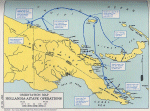
1018152501 |
206k |
Namesake
Hollandia - The battle for Hollandia took place 22-27 April 1944. The Japanese high command decided to make an all-out effort to hold Western New Guinea. The
Second Area Army had established a major supply and maintenance base at Hollandia, 500 miles west of Saidor and beyond the reach of Kenny’s fighter
aircraft, whose range was about 350 miles. They began to construct airfields for future defensive and offensive air operations. By April, 3 of these were ready,
located several miles inland, behind coastal mountains. Knowing that MacArthur had never made an attack beyond the range of fighter aircraft, they had few security
troops at Hollandia. MacArthur, however had decided to bypass the Eighteenth Army and to strike at Hollandia itself. Admiral Nimitz provided air support and air
cover until land-based air could take over. Because of the danger of operating so near to Japanese air bases in New Guinea and the Carolines, the carriers could stay
in the coastal waters of New Guinea for only 4 days. Thus, it was essential that MacArthur obtain a secure base for land-based fighters, in range of Hollandia,
before the carriers withdrew. With excellent carrier support, the American divisions converged inland against the Japanese airfields. Japanese resistance was light due to
the complete surprise achieved. When the carriers withdrew on April 26, land based fighters from Aitape were available to provide support and cover. American losses
were about 100 dead and 1,000 wounded; the Japanese losses were more than 5,000 dead; about an equivalent number of survivors fled to the jungle.
Photo - LSTs at Hollandia, 22 April 1944, U.S. Navy from the USS Bunker Hill (CV-17) 1943-1944 cruise book
Map - Hollandia–Aitape operations map. Engineers of the Southwest Pacific, 1941-1945, Vol. 1: Engineers in Theater Operations. Reports of Operations (of the) United States
Army Forces in the Far East, Southwest Pacific Area, Army Forces, Pacific" by Office of the Chief Engineer, General Headquarters, Army Forces Pacific, Washington, U.S. Govt. Print.
Office, 1947. (Wikipedia) |
Tommy Trampp |

